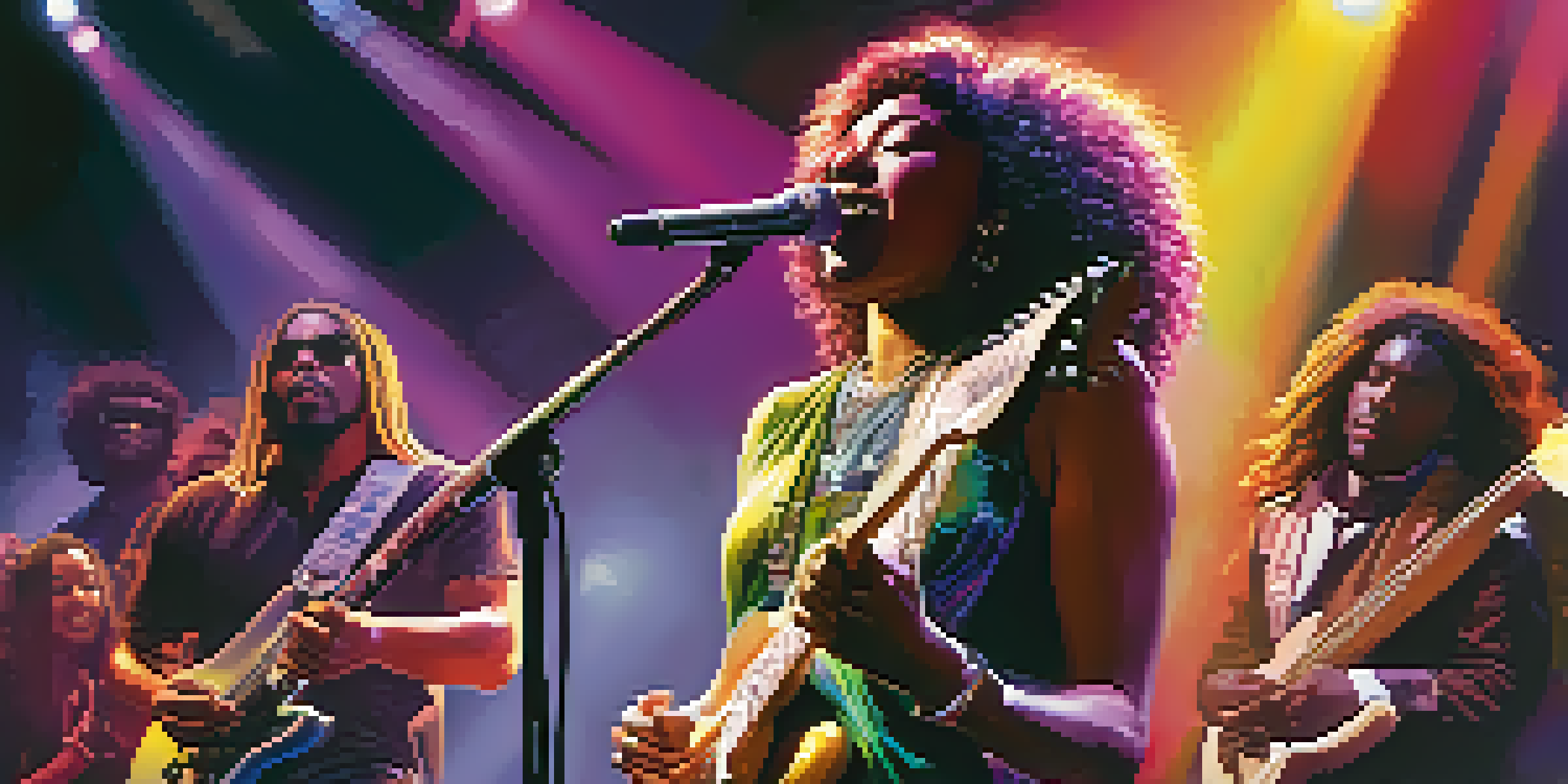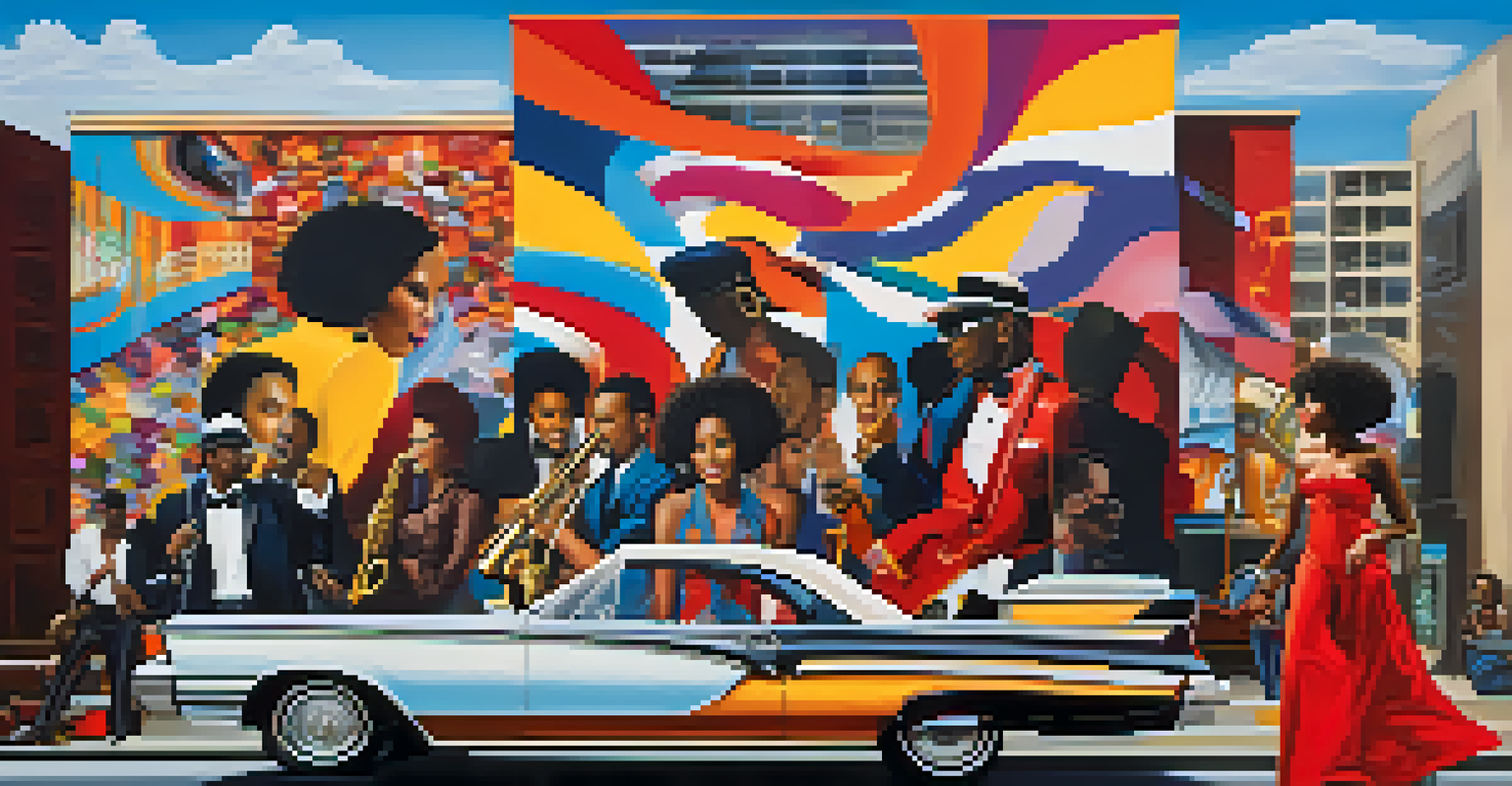The Impact of R&B on Contemporary Rock Music Trends

The Roots of R&B and Its Evolution Over Time
Rhythm and Blues, commonly known as R&B, originated in the 1940s, blending jazz, gospel, and blues. This genre quickly evolved, becoming a staple in American music culture. Artists like Ray Charles and Aretha Franklin were pivotal in popularizing R&B, infusing it with emotional depth and lyrical storytelling.
Music is the universal language of mankind.
As R&B continued to grow, it influenced various genres, including rock. The catchy hooks and soulful melodies found in R&B music began to seep into rock, creating a vibrant cross-pollination of styles. This evolution laid the groundwork for the genres to intertwine in the decades that followed.
Today, R&B is not just a genre; it’s a significant influence on modern music, including rock. With artists continuously experimenting, the boundaries of R&B and rock are increasingly blurred, showcasing the dynamic relationship between these two powerful genres.
Key Artists Merging R&B and Rock Sounds
Some contemporary artists have become notable for merging R&B and rock sounds, creating a unique musical experience. For instance, artists like H.E.R. and John Mayer have incorporated R&B elements into their rock-infused tracks, appealing to a broader audience. This blending of styles has opened doors for new musical expressions.

Additionally, legends like Prince and Lenny Kravitz have long been known for their ability to fuse R&B grooves with rock's raw energy. Their music showcases how the two genres can complement each other, crafting songs that resonate with fans of both styles. This crossover has created a lasting legacy that continues to inspire new artists.
R&B's Historical Evolution
Rhythm and Blues emerged in the 1940s, blending jazz, gospel, and blues, and has since evolved to influence modern music genres.
As these artists influence the next generation, we see a rise in collaborations that reflect the synergy between R&B and rock. This trend not only garners interest from diverse listeners but also encourages musicians to explore new territories in their sound.
The Role of Production in Blending Genres
In contemporary music, production plays a crucial role in merging R&B and rock. Producers today utilize advanced technology and techniques to create sounds that capture the essence of both genres. This innovation allows for the layering of smooth R&B vocals over driving rock instrumentals, resulting in a fresh auditory experience.
The beautiful thing about music is that it connects people.
For example, the use of electronic elements and sampling has become prevalent, giving rise to hybrid tracks that evoke the spirit of both genres. Producers like Pharrell Williams have pioneered this approach, crafting songs that appeal to fans of various musical backgrounds. Their work exemplifies how modern production techniques can bridge the gap between R&B and rock.
Moreover, the accessibility of digital tools has empowered independent artists to experiment with these sounds. They no longer need a major label to produce genre-blending tracks, enabling a flourishing of creativity that emphasizes personal expression while drawing from diverse influences.
Lyrical Themes: Love, Struggles, and Identity
One significant aspect where R&B has impacted rock music is in the lyrical themes. Both genres often explore deep emotions, with love, struggles, and identity being central topics. This thematic overlap allows songwriters to connect with listeners on a personal level, regardless of the genre.
For instance, while rock songs might tackle themes of heartbreak or rebellion, R&B often approaches these subjects with a soulful introspection. This combination offers a richer narrative, giving audiences a multifaceted understanding of the artist's experiences. The blending of these lyrical styles has led to a more profound emotional resonance in contemporary music.
Merging Sounds of R&B and Rock
Contemporary artists like H.E.R. and John Mayer are successfully blending R&B and rock elements, creating fresh musical experiences.
Artists like Anderson .Paak seamlessly weave R&B's soulful storytelling with rock's rebellious spirit. Their lyrics often reflect personal journeys, creating relatable content that appeals to a diverse fanbase. This shared exploration of human experiences continues to shape the evolving landscape of rock music.
The Impact of R&B on Rock Subgenres
R&B has significantly influenced various rock subgenres, particularly alternative rock and pop-rock. Bands like Maroon 5 and The 1975 have embraced R&B rhythms and vocal styles, contributing to their distinctive sounds. This blend has allowed them to reach wider audiences while still maintaining their rock roots.
Moreover, the emergence of neo-soul has further blurred the lines between R&B and rock. Artists like Erykah Badu and D'Angelo incorporate rock elements into their music, showcasing how these genres can coexist and thrive together. This cross-pollination enriches the musical landscape, encouraging experimentation and innovation.
As artists continue to draw inspiration from R&B, we see the rise of new subgenres that challenge traditional definitions. This evolution not only broadens the appeal of rock music but also invites listeners to appreciate the diverse influences that shape it.
The Influence of R&B on Live Performances
Live performances have seen a transformation due to the influence of R&B on rock music. Artists are increasingly incorporating R&B-inspired showmanship into their concerts, elevating the overall experience for fans. This focus on performance has shifted how audiences engage with live music, making concerts more dynamic and interactive.
For example, artists like Bruno Mars and Janelle Monáe bring high-energy choreography and soulful vocals to their shows, drawing from both R&B and rock traditions. Their performances emphasize the importance of connection with the audience, creating an electrifying atmosphere that resonates long after the show ends. This approach has set new standards for live entertainment.
Future of R&B and Rock Fusion
The fusion of R&B and rock continues to thrive, driven by artist experimentation and the accessibility of digital tools.
As a result, rock bands are also adapting by infusing more theatrics and engaging performances into their sets. This influence not only enhances the concert experience but also encourages artists to push their creative boundaries, resulting in unforgettable musical moments.
Future Trends: The Continued Fusion of R&B and Rock
Looking ahead, the fusion of R&B and rock shows no signs of slowing down. As more artists experiment with blending these genres, we can anticipate an even greater variety of sounds and styles. This ongoing evolution is a testament to the adaptability and resilience of both genres within the music industry.
Additionally, the rise of streaming platforms has created opportunities for niche genres to gain traction. As listeners explore diverse musical landscapes, they are increasingly drawn to the captivating blend of R&B and rock. This trend allows artists to reach new audiences while celebrating their unique influences.

Ultimately, the future of rock music will likely be shaped by the continued exploration of R&B elements, fostering a rich tapestry of sounds that appeal to a wide range of listeners. As these genres evolve together, we can expect an exciting musical journey ahead, filled with creativity and innovation.